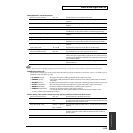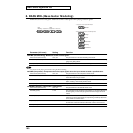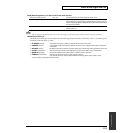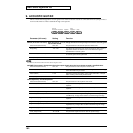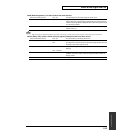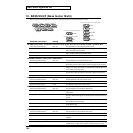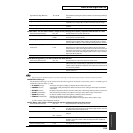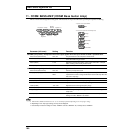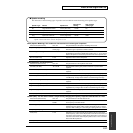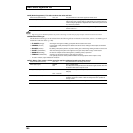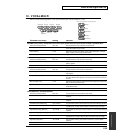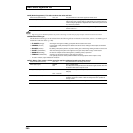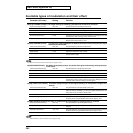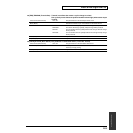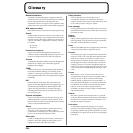
197
Insert effect algorithm list
Insert effect algorithm list
● SP (Speaker Modeling): This models the characteristics of various types of speakers.
Effect On/Off (Effect On/Off) OFF, ON This parameter turns the speaker modeling effect on/off.
Speaker Type (Speaker Type) See the column
on this page. Selects the type of speaker that will be modeled.
Mic Setting (Mic Setting) CENTER, 1–10 cm This models the microphone position. “CENTER” models the condition that
the microphone is set in the middle of the speaker cone. “1–10 cm” means
that the microphone is moved away from the center of the speaker cone.
Mic Level (Mic Level) 0–100 Adjusts the volume of the microphone.
Direct Level (Direct Level) 0–100 Adjusts the volume of the direct sound.
● EQ (Equalizer): A 4-band equalizer.
Effect On/Off (Effect On/Off) OFF, ON This parameter turns the equalizer effect on/off.
Low Gain (Low Gain) -20–+20 dB This parameter sets the gain (amount of boost or cut) for the bass
equalizer.
Low-Mid Gain (Low-Mid Gain) -20–+20 dB This parameter sets the gain (amount of boost or cut) for the low-midrange
equalizer.
Low-Mid Freq (Low-Mid Freq) 100–10.0 kHz This parameter sets the central frequency for the low-midrange equalizer.
Low-Mid Q (Low-Mid Q) 0.5–16 This parameter sets the range of change in gain for the frequency set by
“Low-Mid Freq.” A larger value results in a narrower range of change.
High-Mid Gain (High-Mid Gain) -20–+20 dB This parameter sets the gain (amount of boost or cut) for the high-midrange
equalizer.
High-Mid Freq (High-Mid Freq) 100–10.0 kHz This parameter sets the central frequency for the high-midrange equalizer.
High-Mid Q (High-Mid Q) 0.5–16 This parameter sets the range of change in gain for the frequency set by
“High-Mid Freq.” A larger value results in a narrower range of change.
High Gain (High Gain) -20–+20 dB This parameter sets the gain (amount of boost or cut) for the treble
equalizer.
Level (Output Level) -20–+20 dB This parameter adjusts the volume after the equalizer stage.
● WAH (Wah): The wah effect creates a unique tone by changing the frequency response characteristics of a filter.
Effect On/Off (Effect On/Off) OFF, ON This parameter turns the wah effect on/off.
Polarity (Polarity) UP The frequency of the filter will rise.
DOWN The frequency of the filter will fall.
Sensitivity (Sens) 0–100 This adjusts the sensitivity at which the filter will change in the direction
determined by the polarity setting. Higher values will result in a stronger
response. With a setting of “0,” the strength of picking will have no effect.
Frequency (Frequency) 0–100 This adjusts the center frequency of the Wah effect.
Peak (Peak) 0–100 Adjusts the way in which the wah effect applies to the area around the
center frequency. Lower values will produce a wah effect over a wide area
around the center frequency. Higher values will produce a wah effect in a
narrow area around the center frequency.With a value of “50” a standard
wah sound will be produced.
Level (Level) 0–100 Adjusts the volume.
■ Speaker modeling
The characters of the following types of speakers can be modeled. Set the desired type for Speaker Type.
Microphone Well-matched
Speaker Type Cabinet Speaker Unit Setting
*
preamp type
AC Large Sealed enclosure 15 inch (two units) On Mic AC
ac Open-back enclosure 15 inch (two units) Off Mic AC
AMG Open-back enclosure 10 inch (eight units) On Mic AMG
amg Open-back enclosure 10 inch (eight units) Off Mic AMG
* “On Mic” models sound when a dynamic microphone is used.
“Off Mic” models sound when a condenser microphone is used.



